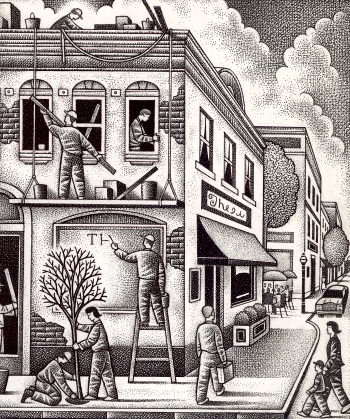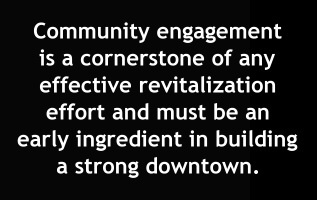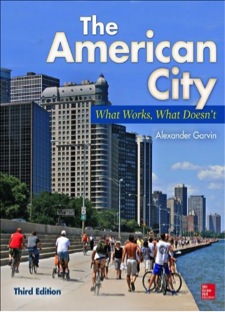 My September article at Planners Web began making a case for why, “A Healthy Downtown is Key to a Strong Community.”
My September article at Planners Web began making a case for why, “A Healthy Downtown is Key to a Strong Community.”
Now let’s explore seven critical ingredients for building a strong downtown.
As the last several generations of Americans have found, building strong communities is not an exact science.
Cities are one of the most complex ecosystems on earth. Many of our past urban interventions have had unintended consequences that took decades to understand and to repair.

However, due to the renewed interest in city building and recent innovative urban initiatives, I am bullish on the future of central cities. It seems that urbanists are learning from the mistakes of the past and working to make a quality urban lifestyle possible again.
Unfortunately revitalizing urban neighborhoods is a slow incremental process in our current world of instant gratification. Therefore if we can establish a recipe for building healthy communities, just maybe we can accelerate the process.
Our grandmothers could single handedly make that perfect meal without the benefit of a written list of ingredients; however it takes a village to make a strong community. Community building is a team sport with many players who must be working in concert to make great things happen. Hopefully this list of ingredients can help lead to a recipe for success in revitalizing your downtown.
Ingredients:
1. Strong Leadership
2. Effective Community Engagement
3. A Shared Vision and Implementation Plan
4. Policy Alignment and Appropriate Regulation
5. Targeted Incentive Tools
6. An Authorized Entity to Shepherd the Plan
7. Regional Support
1. Strong Leadership
The first, and perhaps most critical ingredient is Strong Leadership. When we think of the traditional leadership role, we think of it being filled by a charismatic elected official such as Joseph P. Riley Jr., Mayor of Charleston, South Carolina. Riley, widely considered one of the most visionary and highly effective governmental leaders in America, reminds us that “cities should be places that make the heart sing.” Mayor Riley has become a leading expert on urban design and livability issues.
Under Mayor Riley, the City of Charleston has a clear vision and the following agreed upon values, which are prominently posted on their website. 1
- We value our diversity and are committed to treating every resident with respect, honesty and courtesy.
- We value every citizen’s safety and understand that safe, public spaces and neighborhoods are essential to our quality of life.
- We value providing high quality municipal services at the lowest possible cost to our residents. We value our unique natural resources, our man-made environment, public realm and neighborhoods, and we understand how our physical place affects each resident’s quality of life.
- We will work with others to increase the sustainability of our physical place.
- We value working with other government entities within our region to sustain and improve the quality of life for all citizens.
While it is helpful to have a strong mayor or city manager steering the downtown revitalization effort, leadership can come in many different forms and from many different places. Civic leadership expert Otis White made this point in his 2011 “Making a Difference” article, where he profiled planning commission chair Reeve Hennion. 2 Hennion helped his community navigate major changes while having little formal regulatory power.
2. Effective Community Engagement
It is widely recognized that neighborhood organizations and individual stakeholders need a voice in the revitalization process in their downtowns. Involving community members in creating strategies and implementation decisions is critical. Effective community engagement builds skills and capacity within the community, which are fundamental assets in revitalizing downtowns. Each downtown development decision affects a broader segment of the population than decisions in smaller more isolated neighborhoods.

The International Association for Public Participation defines “constructive citizen participation” as:
“a systematic process that provides an opportunity for citizens, planners, managers, and elected representatives to share their experience, knowledge, and goals, and combine their energy to create a plan that is technically sound, economically attractive, generally understood and accepted by most of those affected by it, and is thus politically viable.” 3
Community engagement is a cornerstone of any effective revitalization effort and must be an early ingredient in building a strong downtown.
3. A Shared Vision and Implementation Plan
Downtowns typically represent the image of a city to the rest of the world. Downtowns are also unique in that they are typically the only neighborhood that belongs to everyone in the region. Therefore it is critical that a shared vision of downtown and a plan to fulfill that vision be developed. Plans come in many shapes and sizes but regardless of their scope it is critical that the plan comes from within and truly represents the unique character and issues of that specific community.
An effective plan should clearly illustrate a community’s shared vision and define the path toward implementing that vision. The planning process should result in specific goals, objectives, and strategies for both short and long-term milestones. The successful implementation of any plan is dependent on aligning public policy and appropriate regulation with these goals and objectives.
4. Policy Alignment and Appropriate Regulation
Public Policy creates the framework for future growth and development within a community. Policy determines the focus of public resources and directs the path of private investment. Community plans should call for public action that generates a positive market reaction.
 Alexander Garvin, noted author of The American City, calls for “a new approach to planning that explicitly deals with both public action and the probable market reaction.” 4 Garvin focuses on the desired change resulting from the public action; the key being the change – either encouraging desirable change or preventing undesirable change. Policy changes can take the form of regulation, incentives, or strategic public investment.
Alexander Garvin, noted author of The American City, calls for “a new approach to planning that explicitly deals with both public action and the probable market reaction.” 4 Garvin focuses on the desired change resulting from the public action; the key being the change – either encouraging desirable change or preventing undesirable change. Policy changes can take the form of regulation, incentives, or strategic public investment.
Alexander Garvin, noted author of The American City calls for a new approach to planning that explicitly deals with both public action and the probable market reaction.
It is critical for government policies to support and reinforce the community’s goals. Downtowns are greatly affected by the decisions policy makers make regarding land-use planning, transportation projects, public safety, social services, and countless other issues. If public policies are inconsistent with the redevelopment strategy, little progress can be made.
Today land use and development regulation is a hotly debated issue in many communities throughout the U.S. It is most often used to alter the growth, size, and character of the community and the design of the physical environment. Therefore it is critical that current regulations reflect the goals, objectives, and future vision for the community. If so, then planning commissioners can rely on them to help reinforce their authority and decision making.
Throughout the U.S., a new generation of land use ordinances is gaining favor among city planning officials. Referred to as form-based codes, these ordinances regulate what really matters: a building’s height, disposition, location, relationship to the street, and where to place parking.
The recently adopted form-based code in Memphis, Tennessee, called The Unified Development Code, for example, provides a form-based regulatory tool-kit to protect existing neighborhood investments from incompatible building forms while promoting a pedestrian friendly environment. Its stated purpose is to: “Promote reinvestment and revitalization of the urban core while providing for orderly development in the suburban and exurban areas of the County.”
In Part 2 of the article, Andy Kitsinger covers three other aspects of building a healthy downtown:
5. Targeted Incentive Tools
6. An Authorized Entity to Shepherd the Plan
7. Regional Support
Andy Kitsinger is a principal consultant at The Development Studio, a firm focused on helping clients build stronger communities. He writes about Downtown and Main Street Issues.
Kitsinger’s thirty-year career as an architect, urban designer, city planner, and teacher has focused on creating authentic places that are strongly influenced by their context and have a positive impact on their community. He teaches Issues in City Building and Architectural Design Studio at the University of Memphis’ Department of Architecture.
Kitsinger served as the Senior Vice President of Planning & Development for the Downtown Memphis Commission (formally Center City Commission) for the last eight plus years where he helped continue the momentum of downtown while working to improve the livability and the quality of life in the City.
We look forward to upcoming columns by Kitsinger on a range of downtown and main street issues.
Notes:
- City of Charleston, South Carolina, “Mission & Value Statements.” ↩
- Otis White, “Making a Difference,” (Planning Commissioners Journal, Fall 2011) ↩
- See International Association for Public Participation web page ↩
- Alexander Garvin, The American City (New York, NY, McGraw Hill, 2002) p. 8 ↩